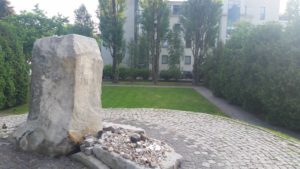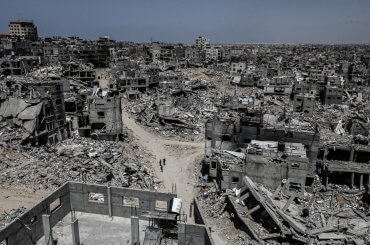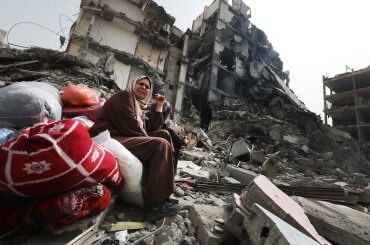For a long time I have had the words echoing in my mind, “Where were the Jews supposed to go?” said by a friend with Polish roots, and I’ve wanted to go to Poland to face the question. On my latest trip to the Middle East I threw in two days in Poland on the return. And now I want to go back.
I spent my time walking around Jewish Warsaw or what is left of it and visiting the site of the death camp, Treblinka, 60 miles to the northeast. The overall impression I carried away was, Poland is mine, too. Here people to whom I am related were subject to genocide. The memorials to Jewish life in Poland are paltry given how much Jews did for Poland, and how much they suffered there. The absence of Jews is hurting Poland and Jews too, and American Jews ought to do more to commemorate and foster Jewish Poland.


As to the memorials, we were more than 3 million here once. The museum of Polish Jewish history at the north end of the former ghetto is pretty good if a bit didactic (things are hopeful in the last hall) and not nearly enough. The memorial at the Umschlagplatz, the train platform where the Jews were packed off to Treblinka from Warsaw, is unarresting. The monument to the Warsaw Ghetto uprising is fine; the memorial to Mila 18, the bunker where Jewish resisters committed suicide as the Nazis closed in, is beautiful and poetical, but terribly undersold. Neither has anything on the scale of the dramatic Polish monuments you see to the Polish resistance and uprising.
The former ghetto is underclaimed. No maps. Few markers. A section of the original wall that still exists in a commercial district (Walicow Street) is so unadvertised I didn’t realize “That was the wall” till I got home.

Treblinka, where several hundreds of thousands of Jews and others were murdered from July 1942 to August 1943, is also understated. The museum looks like a hut. Alright– this was a camp in the woods. But not all the displays are in English and they lack the drama that even a little reading about Treblinka’s unending year of horrors will give you. The actual killing center, which the Nazis sought to cover up, making it the subject of forensic archaeology, is not memorably curated. There are oversized all-weather photographs of the zoo where the Nazis and Ukrainian guards sought to distract themselves and of the crane the Nazis used to move piles of bodies, and there are concrete ties indicating the path of the railroad, and countless stone monuments to the murdered, but the site lacks awful grandeur, and specific information. I walked through the woods and had no sense that Polish villagers smuggled food to the inmates here, and 150 or so people escaped in the forest in the August 1943 uprising. I had no sense of the enormity, the thousands of suitcases piled and rifled, the line of barbers to shave the women’s heads.

It was a Saturday late in May, and a dozen visitors were there, mostly Danes. There does not seem to be much engagement by the living with the place. Though a tape runs through the woods for a mile or so with the names of many of those killed printed on it.
And Treblinka wasn’t easy to get to. I hitchhiked from the Malkinia train station, four miles away, and back too, crossing the historic Bug River by foot, with no knowledge that this was the line of division between the Red Army and the Germans, when they were cutting Poland up.
Walking back, I saw a stork rise from the bank of the Bug. That was the environmental highlight of my trip, along with the horse chestnuts blooming in Saski Park just outside the unmarked eastern wall of the old Warsaw ghetto.
Poland is surely one of the cheapest countries to visit in Europe. The cab to the airport from downtown was about $12 with tip. My Airbnb was $29 a night. Both nights I ate at an excellent restaurant, traditional with a twist (blood sausage, sauerkraut and wild meat, borscht, herring in linseed oil, beet carpaccio, etc) and it was $25, with wine. The upside of this economy is that Poland seems to have escaped the neoliberal income disparities that have bent the U.S. and western Europe. The downside is the feeling of meagerness. A mantra went through my head: A society will not prosper unless it treats its Jews well. That’s a blackmail I heard down through the years, an understanding murmured or stated in Jewish organizational and communal life. We are an economic engine; America has done so well economically because it has treated Jews well.

A major element of the Holocaust was the confiscation of Jewish property. It is a theme in Samuel Willenberg’s devastatring Treblinka memoir that I bought at the site of the camp. The place was swimming in stolen money, jewelry and valuables. Eva Hoffman’s book Shtetl emphasizes how much Jewish capital was driven from the country, or stolen.

Now Poland is all but Judenrein. My Airbnb host told me his mother walked her best friend to the train in ’68 when 20,000 Jews were expelled from Poland– leaving 10,000. There’s tons of antisemitism here now, too, he said. Including the government’s denial that it had any part in the extermination of Jews, that was all the Germans’ fault. Poland has not come to terms with its own role in the Holocaust. So much is clear from Willenberg’s memoir and Yitzhak Zuckerman’s definitive oral history, and Jan T. Gross’s harsh book Fear on the Jewish experience of Poland after the Holocaust, and Eva Hoffman’s more sympathetic book too, as well as this review of Anna Bikont’s book on the massacre in Jedwabne. Poles sometimes said that Hitler was doing them a favor. They massacred the Jews of Kielce in 1946—two years before Deir Yassin.
Of course many, many Poles saved Jews, and many Poles lost their lives doing so. This heroism also is undermemorialized. I am not trying to put down stakes on this historical controversy, so much as comment on the absence of visible pity for the very worst chapter of Jewish history, the 7 years of being hunted.
The museum of Jewish history is plain about what a big role Jews played in Poland’s history when they were welcome here, from the 1200s on. Jews served a vital economic role in the feudal system, and in urbanizing Poland, Eva Hoffman writes in Shtetl. In the 1800’s and early 1900’s, Jews made a flourishing culture in Warsaw and other cities. I think of the great Yiddish works of Isaac Bashevis Singer, but the museum features the music, the theater, the literary gatherings, the publishing, and the industrial innovation too. Even as he was moving from abandoned house to abandoned house in the ghetto, the great resistance leader Yitzhak Zuckerman collected Jewish libraries, and finding three volumes of S.Y. Agnon, managed to escape in them.
And it’s all gone. A professor of Jewish studies once told me that in Israel the remnant salvaged a culture that had been wiped away in eastern Europe. But it’s not the same. They’re different places, different times. One is simply gone. I felt the ache the whole time I was there.
Where should the Jews have gone? They should have gone anywhere they could, of course, to save their lives. I understand why so many Zionists regarded “Eretz Israel” as the great future. I take no part in the sectarian ideological disputes between Bundists and Zionists (and Betar, Gordonia, Poale Zion, Hashomer Hatzair, Dror, etc). So many brave Jews were involved in the struggle to save Jews in Poland; I honor their memory. When the Ghetto was formed, Zuckerman put together a compilation of Jewish history to try to explain to Jews what was upon them. He thought, a big pogrom. A year later his friend Frumka Plotnitzka sent a coded letter to the outside world, signed “special regards from Hashmada Gmura.” Total destruction. Plotnitzka died in the uprising.

Of course today the Warsaw Ghetto Uprising memorial is draped with Zionist propaganda. And the Zionists are shooting unarmed Palestinians at the Gaza fence. Israeli Jews are taking zest in the slaughter of innocent Palestinians; the Palestinians have been successfully dehumanized. Just as Gross and Bikont’s studies say that the Polish gentiles took pleasure in killing Jews, that they were accessories with relish. My visit reminds me, Any people are capable of genocide. It is in our tribal DNA, and certain circumstances can unleash it.
There is such a danger in defining communities on an ethno-nationalist basis. I found support in Poland for my own assimilationist choices. Jews were vulnerable to social ostracization in part because they were self-isolating. One of the themes of the Warsaw memoirs is utter separateness. Survivors were often the best speakers of common Polish (and the most Aryan looking, as the memoirists write) so they were able to vanish into the population. “The impact of Polish prejudices was perforce far more injurious to the Jews than vice versa,” Eva Hoffman writes in Shtetl. But Jewish separation was an “active choice” that created a “solipsism,” she writes. “It also had its consequences. It meant that Jewish individuals and communities cultivated their own alienness, and that although they were willing to engage in contractual relations with the Poles, they did not wish to enter into a shared world with them.”
Our world is a shared world, and Jews, in my portion of historical experience, exercise too much cultural political and economic power to set themselves apart in an unshared world.
When I first got to Israel I wanted to go back and back, to explore this astonishing Jewish experiment, and understand all the ways it failed; and now I feel the same personal moment about Poland. This was my homeland too, once, and I feel deep connections to its urban culture. I’m told that Jews are coming out of the woodwork in Poland, that the children and grandchildren of Jews who pretended they were gentile during the Holocaust are reclaiming their Jewish past, and that there are more and more Jewish initiatives aimed at cultivating Poland. Advancing that Jewish future is more meaningful and hopeful than fostering the Jewish state.
H/t James North, Martin Burcharth, Lizzy Ratner, and Scott Roth.



So you can hitchhike safely in Poland? Try it in the USA.
.@EdnaFriedberg on the coming struggle in Poland over the memory of the Holocaust http://www.theatlantic.com/international/archive/2018/02/poland-holocaust-death-camps/552455/?utm_source=twb
Re: ” The upside of this economy is that Poland seems to have escaped the neoliberal income disparities that have bent the U.S. and western Europe. The downside is the feeling of meagerness. A mantra went through my head: A society will not prosper unless it treats its Jews well. That’s a blackmail I heard down through the years, an understanding murmured or stated in Jewish organizational and communal life. We are an economic engine; America has done so well economically because it has treated Jews well.”
So, America has done so well economically because it has treated Jews so well, but America’s huge and growing income disparities have nothing to do with its treatment of its Jews? Just asking.
Re: “The museum of Jewish history is plain about what a big role Jews played in Poland’s history when they were welcome here, from the 1200s on. Jews served a vital economic role in the feudal system, and in urbanizing Poland…”
The book 200 Years Together has a lot of additional insight on this subject in case anyone here is interested. The book is written by the Noble Prize winner, Aleksandr Solzhenitsyn
“America has done so well economically because it has treated Jews well.”
Neoliberalism has destroyed the US.
Such a beautiful essay, Phil. Thank you for sharing it!